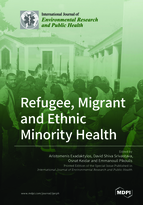Refugee, Migrant and Ethnic Minority Health
A special issue of International Journal of Environmental Research and Public Health (ISSN 1660-4601). This special issue belongs to the section "Global Health".
Deadline for manuscript submissions: closed (30 June 2018) | Viewed by 282655
Special Issue Editors
Interests: trauma; migration; digital medicine; telemedicine
Interests: public health; hospital management
Interests: health promotion; gender medicine; health inequalities; physical activity
Special Issue Information
Dear Colleagues,
Care for migrants and refugees has become a global public health top priority.
Approximately 65.3 million people have been forcibly displaced due to conflict or persecution according to the United Nations High Commissioner for Refugees (UNHCR).
Communicable and non-communicable diseases such as diabetes, cancer, cardiovascular diseases and mental health problems cause a high burden for individuals and healthcare systems.
Given the potentially heterogeneous features of the migrant population, policy makers need indicators and results of quantitative studies to evaluate and monitor the health needs of this population.
We are organizing a Special Issue on health in adult and minor refugees, as well as in economic migrants of non-refugee backgrounds, independent from their country of origin in the International Journal of Environmental Research and Public Health (IJERPH).
This open access journal is a peer-reviewed and PubMed listed scientific journal that publishes articles and communications in the interdisciplinary area of environmental health sciences and public health. For detailed information on the journal, we refer you to https://www.mdpi.com/journal/ijerph.
This Special Issue is open to any subject area related to the health of this vulnerable population group. We welcome review papers, case reports, original research as well as commentaries related to this field of research.
Prof. Dr. Aristomenis Exadaktylos
Dr. David Shiva Srivastava
Dr. Osnat Keidar
Prof. Dr. Emmanouil Pikoulis
Guest Editors
Manuscript Submission Information
Manuscripts should be submitted online at www.mdpi.com by registering and logging in to this website. Once you are registered, click here to go to the submission form. Manuscripts can be submitted until the deadline. All submissions that pass pre-check are peer-reviewed. Accepted papers will be published continuously in the journal (as soon as accepted) and will be listed together on the special issue website. Research articles, review articles as well as short communications are invited. For planned papers, a title and short abstract (about 100 words) can be sent to the Editorial Office for announcement on this website.
Submitted manuscripts should not have been published previously, nor be under consideration for publication elsewhere (except conference proceedings papers). All manuscripts are thoroughly refereed through a single-blind peer-review process. A guide for authors and other relevant information for submission of manuscripts is available on the Instructions for Authors page. International Journal of Environmental Research and Public Health is an international peer-reviewed open access monthly journal published by MDPI.
Please visit the Instructions for Authors page before submitting a manuscript. The Article Processing Charge (APC) for publication in this open access journal is 2500 CHF (Swiss Francs). Submitted papers should be well formatted and use good English. Authors may use MDPI's English editing service prior to publication or during author revisions.
Keywords
- Refugees
- Asylum seekers
- Migrants
- Health
- Injury
- Prevention
- Public health
- Rehabilitation
Benefits of Publishing in a Special Issue
- Ease of navigation: Grouping papers by topic helps scholars navigate broad scope journals more efficiently.
- Greater discoverability: Special Issues support the reach and impact of scientific research. Articles in Special Issues are more discoverable and cited more frequently.
- Expansion of research network: Special Issues facilitate connections among authors, fostering scientific collaborations.
- External promotion: Articles in Special Issues are often promoted through the journal's social media, increasing their visibility.
- Reprint: MDPI Books provides the opportunity to republish successful Special Issues in book format, both online and in print.
Further information on MDPI's Special Issue policies can be found here.









